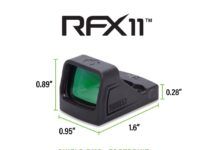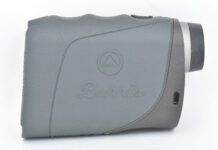The AR-15’s popularity is partially due to the weapon’s modularity, light weight, and fast handling. But too much technology hung off every rail can morph the AR into an unwieldy and overly complicated rig—turning “tactical” into “tacticool.”
Multifunction devices that combine optical laser and lighting into a vertical grip platform can help keep your rifle trim and uncluttered. We recently tested four such laser/light foregrips from three manufacturers. From MidwayUSA we bought two models made by Crimson Trace Corporation, the MVF-515 Red ($399, # 211142) and the MVF-515 Green ($599, # 812310). Both grips use a dual output 150-/200-lumen LED and feature independent controls for the light and laser. The now-discontinued but inexpensive Lasermax Colt AR-15 CGL Foregrip Laser ($161 at www.CheaperThanDirt.com, #61493) combines a red laser with a low-output LED for navigation lighting. At Sig’s online store www.SigSauer.com, we found the Sig Sauer Stoplite STL-300J, $215, which combines a monstrous 700-lumen tactical light with a red laser.
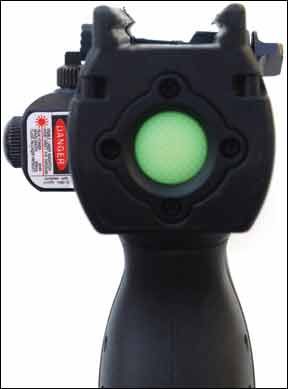
How We Tested
Our team tested the operating features of each grip at the Bass Pro Shops indoor rifle tunnel located in Grapevine, Texas. Our test gun was a Stag 8L left-handed piston-driven AR equipped with a Samson Star C quad rail. Our shooters first zeroed the rifle with the lasers at 25 yards from a seated bench-supported position. After we were confident in our alignment, we shot for accuracy at the 25-yard mark then progressed to 50 yards. We quickly found that our evaluation was going to be settled on other characteristics than laser performance. At 25 yards all of our
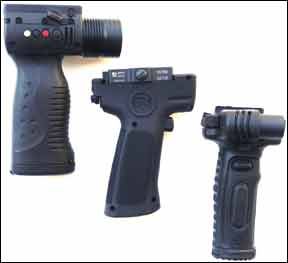
vertical grips produced aiming points that allowed us to shoot zeroed groups less than about 1 inch in diameter. At 50 yards we saw our groups open up to 1.5 inches, but the results were too close to call.
We then began a thorough examination of each grip’s overall fit, finish, and ergonomics. We also took a hard look at what how much value each unit provided for your hard-earned money. This is where we began to see significant differences among the competitors.
Lasermax Colt AR-15 CGL Foregrip Laser, $161
At its inception, the CGL represented a joint project between Colt’s and Lasermax. After we began our test, the Colt-branded version was discontinued, but we still see plenty of the CGLs for sale, many of them deeply discounted from the original $399 MSRP. We paid $161 at Cheaper Than Dirt. Colt and Lasermax offer a three-year warranty on the CGL, which is important because of its production status.
The CGL’s design philosophy differed from the other products in our evaluation. Instead of attempting to fit a flashlight into a vertical grip, the CGL combined a red laser with a 3-lumen LED designed for discreet navigation. As a result, both the single LED and laser can be oriented at the 6 o’clock position under the gun, making for a thinner profile than other combination designs. The grip is molded from Verton, a proprietary nylon said to have excellent heat and impact resistance.
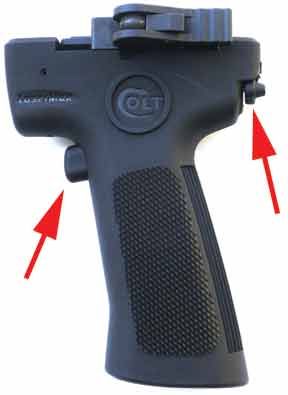
The shape of the CGL closely resembles the shape of the standard AR pistol grip, with molded checkering on its sides and a series of longitudinal ridges along the palm swell. This shape gave the gun a uniform look when the CGL was mounted on its front rail. The CGL used a lever latching system from American Defense to hold fast to our test gun. Adjustable and reversible, the mount uses a folding lever to cam a pressure plate against the Picatinny rail. An inner lever unlocks the plate when depressed. This locking mechanism was both secure and easily removable, and was by far the favorite among our testers.
There were other features of the CGL that found favor with our group. Since there was not a true flashlight on the CGL, it weighed less than its competitors—7.5 ounces on our model, slightly more than its advertised 6.3-ounce weight. It also required less battery power, running on simple AA batteries, rather than the more expensive CR123As required by the Sig Sauer and Crimson Trace models. The CGL is rated at 30 hours on constant laser, 60 hours on pulsing, and 100 hours on LED.
The CGL had a rear-mounted mode selector switch located above the palm swell of the grip. Its operation was ambidextrous with four positions: LED, system off, constant laser, and pulsing laser. Our testers found this system easy to use, and it became intuitive with a little practice. An on/off switch was located on the front of the grip. Momentary on could be activated by pressing down slightly on the switch, or it could be activated to constant on by pressing until it engaged with a rather audible click.
However, our testers weren’t pleased about its noisiness; the clicking sound could notify someone of your presence. They did like the option of constant or pulsing laser. This choice can be beneficial in a couple of situations. Many users find that their eyes can locate a pulsing laser easier than a constant beam. The constant/pulsing option can also help differentiate lasers when working with a partner in close-quarter operations.
Besides the noisy switch, there were a couple of other issues that cost the Colt CGL some points. Battery access required the use of a knife or small slotted screwdriver to remove the battery cover. Our testers also felt the navigation light was a bit too stealthy. Our sample grip used a red LED that provided minimal illumination. More LEDs would provide better lighting, without compromising nighttime vision, or overwhelming night vision devices.
Our Team Said: At a buck under $400 originally, our testers said the Colt/Lasermax CGL was way overpriced, and they didn’t recommend it, in part because the CGL still requires the purchase of a flashlight (and the rail space to mount it) to come on par with the others. Also, most of today’s high-performance flashlights require the use CR123A batteries, so CGL’s AA power source actually works against it because two types of spares must be carried along.
Sig Sauer Stoplite STL300J, $215
Compared to the subtlety of the Colt CGL, the Sig Sauer Stoplite is in your face with a big presence and all the bells and whistles. That’s not all bad, however. Emerging from its snout with the look of a periscope is a big, bad, and extremely bright 700-lumen (or is it 300-lumen) flashlight. We’ll explain our confusion a bit later.
Powered by four CR123A batteries, the Sig Sauer Stoplite is a handful, weighing at 14.1 ounces. The batteries are inserted from the bottom of the grip with a large
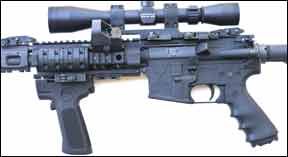
slotted and knurled thumbscrew that holds a nicely hinged battery cap in place. The STL300J has a bulging front with a series of molded horizontal lines and a rubberized palm area with a smattering of circular depressions to provide extra purchase. Small fingers may find it difficult to wrap around its bulbous frame. Weapon mounting is accomplished by sliding its latch bar assembly down the length of the rail to its desired position. An additional locking bolt on the side of the Stoplite can be hand-tightened to further secure the grip. Ironically, we had a Sig 556 SWAT model in-house that wouldn’t accept the Stoplite because the rifle had no rail loading ramp.
The on/off switch for the light is located in the form of a luminescent button on the rear of the Stoplite. On the left-hand side of the STL300J is a red laser-sighting module, which has a pressure-switch jack located under a side-mounted screwdown cap. Laser adjustments can be made with a small slotted screwdriver. The top cap
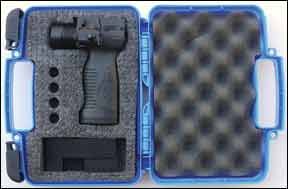
of the laser has a small screwdriver end on it that doubles as a sight adjuster as well, although it can be difficult to hold onto in that use. There is also an accessory power-port cover with a flip-out rubber plug.
On the opposite side of the Stoplite are four buttons, the largest activates the light to constant on, a small red button that activates the laser, a small black button which switches the light mode to steady on, and a small green button that changes the light to a strobe function. If that sounds like a lot of small buttons, you’re right. This cluttered right side of the Stoplite makes operating the laser a dicey proposition, particularly under stress. The location of the buttons causes leftys even more difficulty, forcing the pointer finger off the grip to reach the switches. The Stoplite proved to be a confounding and enigmatic device for us to rate.
This feeling started right out of the box, where the directions included in the box did not match the model we received. A rotary selector switch was indicated where the row of buttons resided. The light is shown as 300 lumens, but is listed as 700 lumens on Sig Sauer’s website. As a result we had to work out the switching on our own. At 300 or 700 lumens, no matter, the thing was blindingly bright, and vertigo-inducing when set on its 18-20 pulses-per-second strobe. However, our testers took
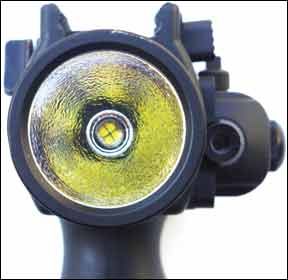
off points for the smallish switches, large frame, and heavy weight.
Our Team Said: At $215 the Sig Sauer Stoplite offers a lot of value for the money, despite its ergonomic shortcomings. If your primary interest is in a darkness defeater, or flash-blinding your dog, this is a solid pick. If your plans include using a laser sight in a high speed/low drag environment, this probably isn’t your first choice.
Crimson Trace Modular Vertical Grip
Model # MVF-515 Red Laser $399Crimson Trace Modular Vertical Grip
MVF-515 Green Laser, $599
We started out our review with the intention of reviewing Crimson Trace’s initial red-laser entry into the multifunction vertical market, when we had the chance to lay our mitts on their new green laser version as well, so we decided to take a close look at both offerings. The features and controls are identical for both models, so we’ll critique their mutual operating systems together, and compare their performance and value propositions at the end of the review.
The Crimson Trace MVFs are built upon a plastic overmolded aluminum frame that looks like a hybrid between the pistol grip shape of its two competitors and the traditional broomhandle look of other vertical grips. Each MVF came in at a relatively svelte 9.3 ounces, heavier than the Colt, but significantly lighter than the similarly equipped Sig Sauer. The back of the grip has a curve, designed to fit more deeply into the palm, than a straight surface with a series of ridges that run horizontally. The ridges are augmented with a heavy-adhesive like that used on non-skid surfaces of boats. The front of the MVF-515 has a ridge that fits between the first two
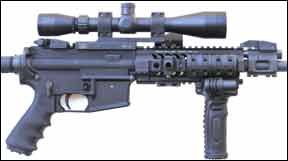
fingers, then curves slightly inward with another swell at its bottom to hold the pinky finger in place. Another block of grit adhesive runs along its length. Initially, our testers had some concern that the grip tape might have too rough a texture, but in practice it provided solid purchase without causing blisters.
Viewed from the rear, a flashlight module is staggered on the right side of the grip, and the laser-sighting unit on the left. The MVF uses notched pressure plates on the front and rear of the grip to secure it in place on a Picatinny-style rail. The plates are tightened using two slotted hex nuts threaded on the left side of the grip. This assembly provided a solid fit, but all of our testers opined that the lever system on the Colt CGL was easier to tighten and retained its zero better than the MVF-515’s clamp.
The flashlight module is rated at 150/200 lumens and is adjusted by twisting its bezel, although our testers didn’t take a significant change in its output after tweaking it. The controls for the light and laser passed muster with both our right-handed and southpaw testers. Each side of the grip had a raised horizontal pressure switch near the top of the grip that controlled the light, and below was a larger, vertically oriented pressure switch activated the laser.
The MVF also featured a small recessed button located on each side, just below the laser and light modules. These buttons served as separate master switches to set the programming of each module. When the switch was depressed on the flashlight side, there was a slight delay, which was then followed by cycling through its programs of momentary activation, strobe, and constant on. Releasing the switch in one of its cycles would activate that particular mode of operation. Our testers were generally satisfied with these programs.
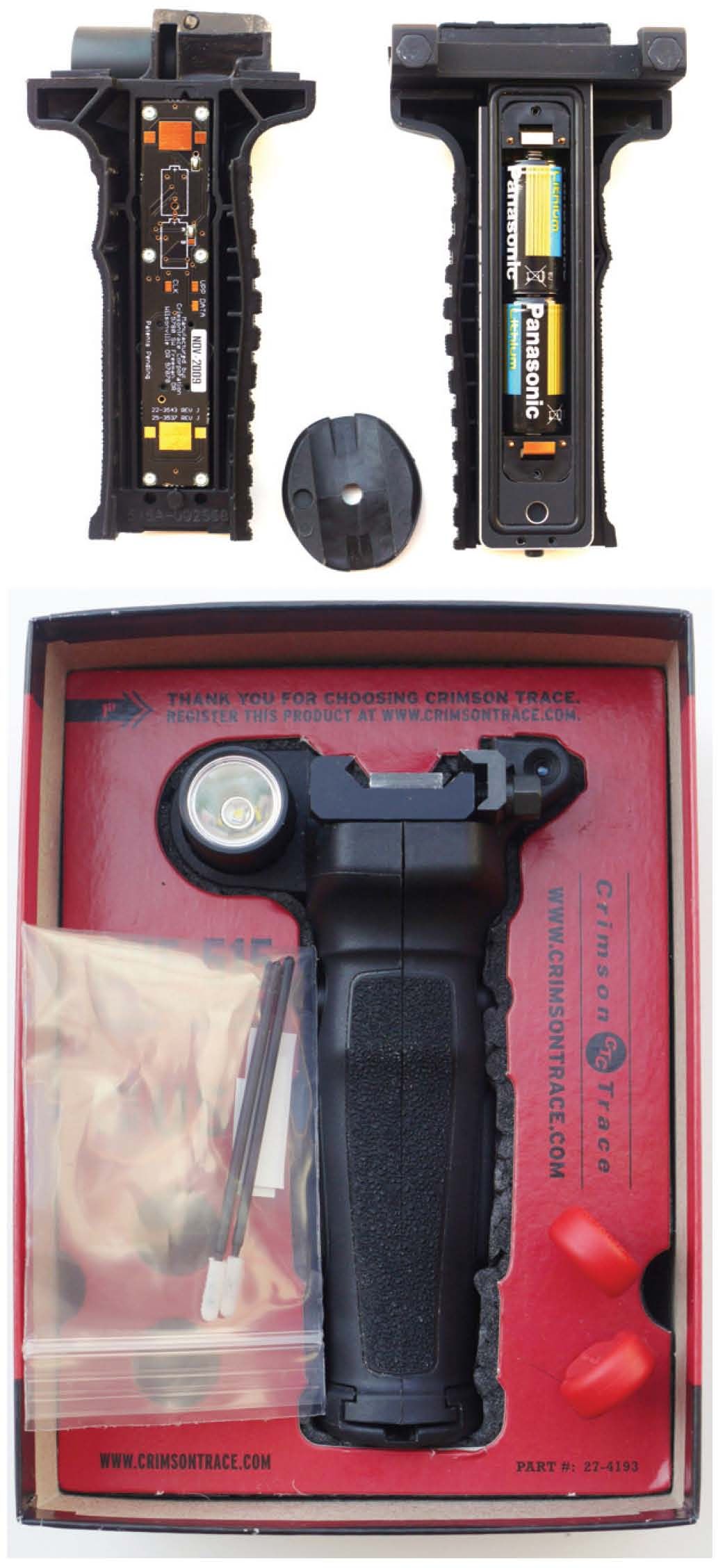
Also, our testers said that the strobe function cycled much more slowly than the bedazzling Stoplite. The laser programs were activated on the other side of the MVF-515 in the same manner, cycling through momentary on, momentary pulsating, and constant on. Both red and green laser units were powered by a pair of CR123A batteries with a rated runtime of 4 hours of illumination or 48 hours of laser only use.
The installation of the batteries caused the greatest number of gripes about an otherwise solid design. To access the battery compartment, a recessed button at the bottom of the grip is pushed, followed by sliding an endplate out of its groove and removing it. The grip is then separated into two halves with the batteries inserted vertically in the half containing the flashlight module. Doing the math on this procedure shows that we have five parts to keep track of, including the batteries. This process became easier with practice, but it is still not user-friendly in the field.
Our Team Said: Our last comparison becomes a matter of price and performance. Is the green laser MVF-515 worth an extra $200? The answer is yes if you are serious about the use of a laser as a sighting tool. We found the Crimson Trace green laser quite visible out around 50 yards even in the bright Texas sun. If you are serious about the use of alternate sighting in all conditions, the green laser is your definite tool of choice. They’re also very, very cool.

























